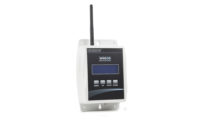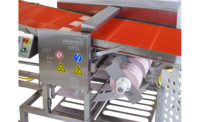CAS DataLoggers, Chesterland, Ohio, provided the automated food safety monitoring solution for Longhini Sausage Co. Inc., a New Haven, Conn.-based sausage processor available in restaurants, delis and supermarkets the Southern Connecticut area for almost 60 years.
While sausage is a quality product, it’s also extremely temperature-sensitive. During storage, if the product temperature rises above 35°F, Rich Longhini, owner of Longhini Sausage, says there’s a problem.
“We load our trucks the afternoon before shipping the next, day and on a given night, I could have $15,000-20,000 worth of product loaded up in my trucks,” says Longhini. “Last year, one of my refrigerated trucks went out of temperature overnight, and this caused us to throw away over $3,000 of product due to a lack of alarms. After that, I wanted to monitor the temperature in the refrigerated compartments, so I would be notified if the temperature rises in the middle of the night.”
Longhini searched for an automated alarm system to monitor the refrigerated trucks (reefer trucks). The primary requirement was for a wireless temperature monitoring system capable of remote alarm notification. Initial systems came at a high cost, including systems expressly designed for tractor trailers. However, Longhini wanted extra functionality.
Effective cold chain monitoring
After searching online, Longhini contacted CAS DataLoggers and installed three T&D’s RTR-500 Wireless Data Logging System and an RTR-500NW Wired Ethernet Network Base Station to collect the temperature readings via a 900MHz wireless transmission.
The three delivery trucks sit in the garage, as they await the morning deliveries, each one with a T&D data logger mounted on the side in an exterior weatherproof box. The T&D RTR-500 series loggers are compact for easy placement. Longhini installed the system himself, drilling a hole in the side of each truck and placing the loggers’ external temperature probes in the warmest part of the refrigerated compartment, running them on the inside roof alongside the refrigeration unit’s own probe.
The external thermistor sensors entail a measuring range of -76°F to 311°F to monitor product or environmental temperature in real time. Users can choose to record in Celsius or Fahrenheit. Each T&D data logger has a large capacity 16,000-point memory along with a battery life of about 10 months. However, Longhini opted for units with an optional large capacity lithium battery pack enabling about 4 years of operation adding to the reliability of the alarm solution on all three refrigerated trucks.
Going wireless
Post-installation, the wireless T&D system now continually monitors the trucks while they’re fully loaded through the night hours. Each of the three data loggers automatically take a temperature sample every 10 minutes without any human intervention.
The T&D RTR-500NW is a network base station with built-in wireless communication and LAN capabilities. This device is located on the garage wall 50 feet away from the trucks, which is within the expected communication range of 500 feet. The RTR-500NW base station automates data retrieval from the data loggers and aggregates the data into one data file. The base station uses a 10/100BaseT Ethernet interface to send data directly to Longhini’s PC.
If needed, changes to settings can be made over the network and sent to the base unit. Alternately, other data collectors are available for sending data via USB, GSM cellular modem, LAN or T&D’s handheld data collectors.
Alarm and remote data transmission
Longhini occasionally views the data from his home PC, but as long as the system is on, his product is continually monitored. His pre-set temperature ranges for this application are 26°F at the low end with a high limit of 35°F, and he adjusted the temperature parameters in the trucks to compensate for defrost cycles. The system’s alarm sampling checks are performed at the same rate as the temperature sampling.
Whenever a reading shows that the sausage product has suddenly gone out of temperature, the base station sends an email alarm via the network directly to Longhini’s email address.
“99% of the time when you get a temperature alarm for food in storage, it’s telling you that you have a real problem and you need to hurry. There aren’t many false alarms, so this usually means the truck refrigeration unit just failed and your safety window is shrinking. You just can’t afford to miss an alarm in this business,” adds Longhini.
Now when a temperature excursion occurs overnight, Longhini will immediately get an alarm notification sent to his mobile device.
“It’d be on a weeknight—I’d first notice it as an email from my phone. From home, I’d log in to the T&D current readings monitor, look at the alarms and then decide what action to take. That could mean emptying the affected truck or moving product from one unit to another, whatever it takes to get it back in temperature spec ASAP,” says Longhini.
Proving product quality to customers
Another business priority for Longhini is archiving the temperature data as proof of product quality. In addition to performing configuration and set-up, the included T&D software enables him to create charts and graphs showing the temperature history.
“It’s a convenient backup that I can use as proof to my customers that my shipments stayed in temperature for the entire length of storage,” says Longhini.
The temperature data can also be sent to the free T&D Cloud where it can be viewed and shared 24/7 via web browser.
Benefits
The T&D RTR-500 Wireless Data Logging System completely automated the Longhini Sausage cold chain monitoring setup. After the quick installation and setup, the trucks are ready to deliver quality product the next morning.






